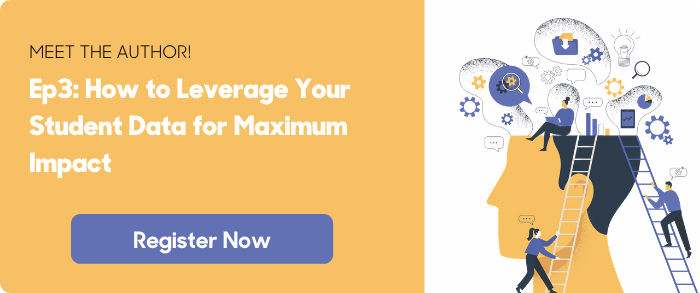-1.png?width=800&name=Blog%20Banners%20(3)-1.png)
 This content is part of our Suitable Innovator badge. Suitable Innovators are trailblazers leading higher education in a new direction. We work with our Suitable Innovators to bring cutting-edge student success thought leadership to you. If you'd like to be considered as a Suitable Innovator, tell us why!
This content is part of our Suitable Innovator badge. Suitable Innovators are trailblazers leading higher education in a new direction. We work with our Suitable Innovators to bring cutting-edge student success thought leadership to you. If you'd like to be considered as a Suitable Innovator, tell us why!
In higher education, we LOVE data. From student outcomes and perceptions to stakeholder engagement and even admissions and recruitment efforts, data has been at the core of evaluating success.
But until recently, we did not fully understand how we could leverage that data to advance our mission and contribute to knowledge within higher education.
This leaves us with some probing questions:
- What is the difference between big data and “good” data?
- How can we make smarter decisions once we gain “good” data?
- How can data be used not only to evaluate outcomes but also to drive program improvements?
- How should we communicate data outcomes to inform and engage key stakeholders?
As a result of trying to answer these and many other questions, we can learn four key lessons that help us better understand student engagement and success through strategic data analytics.
Lesson #1: Big data—or lots of data—does not mean good data.
It is easy to become overwhelmed by the broad, diverse, and large amounts of data our institutions produce. Before adding to our data resources, we should first develop clarity on what knowledge we hope to gain and what data would ultimately help us answer key questions.
Our initial goal should be to make sure that knowledge drives data acquisition and analytics, not the reverse.
To get started, hold discussions with key stakeholders (staff, faculty, alumni, recruiters) to isolate critical questions. This will help your organization to identify what data should be collected, and what data will produce the knowledge that would be useful given strategic goals
Simply put – we must be intentional about data collection strategies, objectives and tools before embarking on collecting “big data”.
Lesson #2: Develop Strategy
Once you agree on key questions, focus on developing an ongoing analytics strategy and execution plan. This includes looking at processes, staffing and communication efforts that are essential in supporting how data is collected and disseminated.
It’s important to recognize that data capture and analyses are a shared responsibility that must include leadership, technical experts, communication experts and key stakeholder groups. For example, student engagement is known to be an important driver of student success. So, a likely area of focus could be how to develop a student engagement scorecard to track the impact on key student outcomes.
In discussions with key stakeholders, we can identify characteristics of our students’ successful outcomes, such as their level of engagement in outside-the-classroom activities. Some examples include participating in student organizations and other campus activities, doing internships or having study abroad experiences.
We can then look at what data platforms and tools are most effective to not only collect needed information but integrate across diverse types and sources of data.
Lesson #3: Take advantage of diverse data with effective data analytics
Sometimes, understanding student success means “pushing the envelope” in terms of the method, type and analysis of our student data. This means taking the time to look at both traditional and non-traditional types of data.
You want to be sure to examine at least two distinct data types: institution-produced and student-produced, or “user-generated”. Taking advantage of diverse types and sources of data can be critical in answering both the “how questions”, which often require descriptive types of data, and the “why questions”, which require more prescriptive types of data.
Creatively using a wide variety of data means balancing both prescriptive and descriptive data that can help universities address student outcomes proactively, not just describe them once they occur.
These diverse data tools can also help us identify not only student engagement and its impact, but student dis-engagement so we can make efforts toward intervention and improvement. Asking both “why?” and “how?” can help to identify opportunities for programmatic intervention when programs don’t achieve desired outcomes while determining why that may
Lesson #4: Acknowledge bias
While it is true that there is power in predictive analytics, “big data” is not a panacea especially within the context of diversity and inclusion. We must acknowledge and take active efforts to address the reality that all data are shaped by human judgment and thinking. How we shape the questions asked of our data, execute data analyses, and provide both interpretations of and actions based on our data are impacted by issues such as implicit and unconscious bias, association or confirmation bias, illusory correlation and other errors in human judgment and decision making.
We must acknowledge also that the selection of data, the definition of models, the interpretations of findings and the actions taken based on findings are inescapably influenced by the same implicit biases that impact everyday human behavior.
In short, placing the label of predictive analytics on data does not ensure that human errors in judgment will not take place– nor does it mitigate the fact that these biases are extremely problematic for achieving goals of diversity and inclusion in higher education.
Some Final Thoughts.
As we pay attention and learn from these four key lessons, we can move from merely collecting data to using data strategically for program improvement. This will help us both demonstrate and improve our impact on key outcomes.
Of course, our efforts with data analytics are not without challenges. We must devote additional effort and resources to manage these initiatives in a way that is both focused and sustainable. We also must take the time to build data literacy among staff, create buy-in across academic units, and link our strategy to important university-wide initiatives.
Finally, we must put into place processes and tools to help us recognize and remove biases in how we design, analyze and interpret our student data. If we keep these lessons in mind, our return on data analytics efforts will be well worth the investment.


-1.png)
